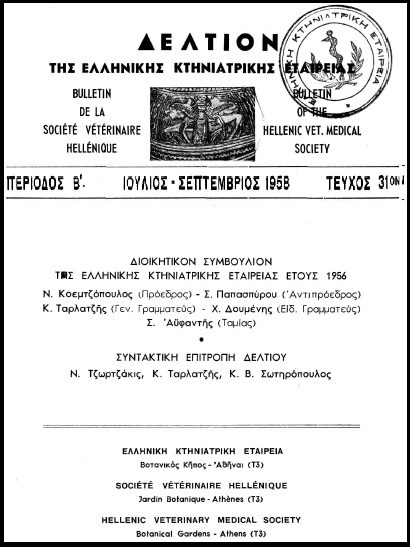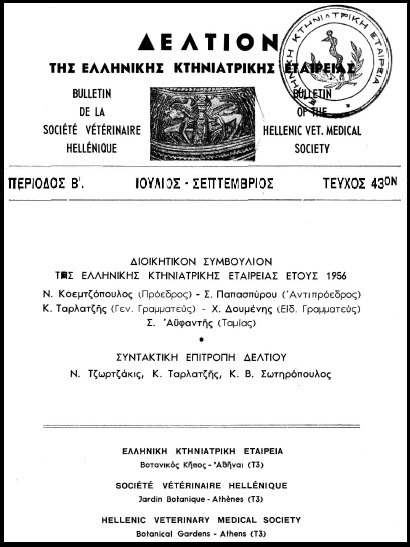Study of the first outbreak of bluetonge disease in sheep in Greece
Abstract
Epidemiological data and the virus isolation concerning the first outbreak of bluetongue, in autumn 1979 in sheep in Lesvos Island are reported. Sixty eight flocks with a total number of 5950 sheep were infected causing a morbidity rate from 10 to 90% and 28% mortality of the diseased sheep. The distance of the place, where the first flock was infected, from Turkish coast is about six miles. The caracteristic of the summer of that year was the prevalance of the strong north-east winds (seasonal winds) and the high temperatures in autumn. The aerogenic route may be the possible route of transmission (cullicoides) , since many years have not been imported runimants in the Island from Turkey ofTicialy. The virus of BT was isolated in chicken embryonated eggs following i/v inoculation. Neutralising antibodies against BTV type 4 were detected in the sera of convalescent sheep. Also, in the Onderstepoort Institute was isolated and identified the virus of BT as type 4 from pathological material we sent.
Article Details
- How to Cite
-
ΜΑΣΤΡΟΠΑΝΝΗ Μ., ΑΞΙΩΤΗ Ι., & ΣΤΟΦΟΡΟΣ Ε. (2019). Study of the first outbreak of bluetonge disease in sheep in Greece. Journal of the Hellenic Veterinary Medical Society, 32(2), 138–144. https://doi.org/10.12681/jhvms.21487
- Issue
- Vol. 32 No. 2 (1981)
- Section
- Articles

This work is licensed under a Creative Commons Attribution-NonCommercial 4.0 International License.
Authors who publish with this journal agree to the following terms:
· Authors retain copyright and grant the journal right of first publication with the work simultaneously licensed under a Creative Commons Attribution Non-Commercial License that allows others to share the work with an acknowledgement of the work's authorship and initial publication in this journal.
· Authors are able to enter into separate, additional contractual arrangements for the non-exclusive distribution of the journal's published version of the work (e.g. post it to an institutional repository or publish it in a book), with an acknowledgement of its initial publication in this journal.
· Authors are permitted and encouraged to post their work online (preferably in institutional repositories or on their website) prior to and during the submission process, as it can lead to productive exchanges, as well as earlier and greater citation of published work.












